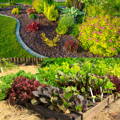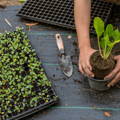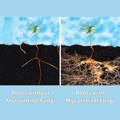Transplanting Tips for a Successful Garden
A Strong Start for a Healthier Garden
Getting your plants off to a strong start ensures healthier, more resistant, and more productive plants. Whether you're starting your yearly vegetable garden, creating a pollinator garden, or adding annuals & perennials to your landscaping, a few simple steps will help ensure a better, more productive growing season.
Most plants for both decorative and food gardens benefit from getting an early start to the season. These young plants, or seedlings, can be started indoors in early spring, or purchased near the optimal planting time at your local nursery. This process allows you to get the most out of the growing season by giving your plants a good head start.
Timing is of the Essence

Hardening off your Seedlings

Transplant Time
It’s best to time your transplanting for late afternoon or early evening to allow your plants to adjust to their new conditions before being exposed to a full day of sunlight. When your transplant day has arrived, start by giving the plants a good watering in their container. Dig the hole for your plant, making sure it is slightly larger than the pot or container your seedling is in. The soil in the hole should be loose, making it easier for the roots to grow once planted.
Carefully remove the seedling from the container while supporting the plant as much as possible. Place the transplant in the hole and gently surround the plant with soil.
Friendly Fungi
Of all the components that make up the Soil Microbiome, one of the most essential for helping plant roots absorb nutrients and water is mycorrhizal fungi. Mycorrhizal fungi form a symbiotic relationship with most plants' root systems, allowing them to grow and thrive in conditions both ideal and less so. In fact, the worse the conditions are in the soil, the more plants want to find and form mycorrhizal partnerships. Once mycorrhizae are connected to roots, the plant's access to water and nutrients (particularly nitrogen, phosphorus, zinc, manganese and copper) increases.
Fortunately, adding this essential ingredient to your soil is quite simple. Root Rescue is a certified organic mycorrhizal inoculant. Mix the concentrated mycorrhizal powder with water and apply it to your new transplants. Once you've introduced Mycorrhizal Fungi to your plant's roots, it goes to work right away and stays with your plant for its entire lifespan. Visit our Science page to learn more about how the beneficial mycorrhizae in Root Rescue improve transplant success, including this study form the University of Guelph.
The first few days of a plant's life in your garden are the most crucial period for establishing the plant's roots; following the simple steps we've outlined gives your plants the best chance at flourishing this season.







